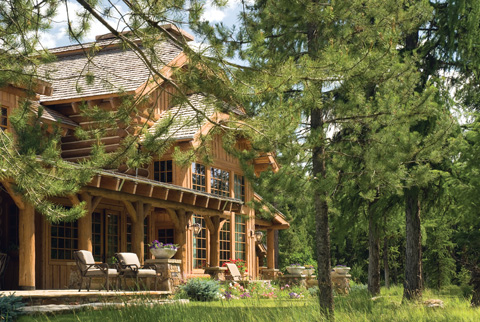For the average individual, buying or selling a home is an event that may occur only once or twice in a lifetime—particularly when the object of the transaction is a log home. The apparently daunting task of securing the best mortgage for the purchase of a log home requires an element of trust in the professionals who provide such services on a regular basis.
Taking the mystery out of the mortgage is one of the primary responsibilities of the real estate professional, and in order to be put at ease as much as possible, the client must have confidence in the individual and the mortgage company or bank that will guide them through the process and provide the necessary financing. Identifying mortgage professionals and products is similar to shopping for anything else. Where are the best product, the best price, and the best service to be found?
“Make sure you are working with a log home-friendly lender,” advises Greg Ebersole of American Log Mortgage. “A lot of times the fact that the property is a log home doesn’t come up in conversation. Sometimes, the loan officer may not realize that you are buying a log home, and there may be different lending parameters from conventional home mortgages. From there, three different situations exist for borrowers: buying, refinancing, or construction.”
Considering today’s economic conditions, Troy Kennedy, a Log and Timber Team Leader with Wells Fargo Home Mortgage, sees a lender’s stability and market reputation as key components of a positive experience. “Work with a stable company,” he stresses. “That is more important than ever now. A company you can count on in construction, purchasing, or refinancing means working with a log home lender that understands each process.
“Borrowers need to understand that construction can involve a 50 percent payment up front before the logs are cut and 50 percent on delivery to the site, for example,” Kennedy continues. “They need to understand the process of qualifying for the loan based on income and expenses, plus the fact that terms are more restrictive in many cases than they have been in the past. Rates are different from lender to lender, and typically 75 percent loan to value will get you our best rate on construction. The equity can come from cash, land value, and deposits that have already been paid on materials.”
Ebersole encourages log home purchasers to shop for the best interest rate available while also considering the terms that apply to the stated rate itself. “The rate that is quoted is as accurate as the information that is asked of the client during the conversation,” he reasons. “If I make the assumption that the client is the cream of the crop and quote them 3.50 percent, the reality may be that they have mediocre credit, and that can affect their actual rate. A lot of rates are specifically consumer driven, and the fact is that stellar credit will get a better rate and more favorable terms.”
Some lenders do place restrictions on loan to value with log homes, particularly with construction requests. Generally, lenders will cap construction loans at 80 percent of appraised value or cost, whichever is lower. In some refinance or purchase situations that do not involve construction, 95 percent loans are available. The tradeoff, however, involves the borrower’s monthly payment.To the typical payment components of principal, interest, and escrow (property taxes and hazard insurance), a mortgage company may be expected to add private mortgage insurance (PMI), which insures the lender against a loss on the credit since the higher loan to value indicates greater risk.
The dynamics of log home appraisal values have changed in recent years as well. Although there are some indications that home values in general are stabilizing, the persistent recession has adversely affected those values. “Borrowers need to understand the uniqueness of the appraisal process due to the economy and with respect to log homes,” notes Kennedy. “Lenders have to be flexible with appraisers on the distance and time between sales of comparable properties along with the use of both log homes and custom conventional sales as comparables because both involve high quality and craftsmanship.”
The appraisal may indeed be the most problematic of issues surrounding a log home transaction these days. “Getting the appraisal to come back strong has been the biggest complication most people have been faced with,” says Andrew West, vice president and wealth management adviser with the West & Gasparini Group. “We try to plan for this by establishing a Plan B or C. Using other assets as collateral can sometimes be necessary to get a new home completed. Using other real estate, a stock or bond portfolio, or even a retirement account can sometimes provide a good backup plan when an appraisal comes in light.”
Despite the adverse economic conditions that have weighed on real estate markets, now is one of the best times in history to purchase, refinance, or build a log home. More home may be purchased for less money. Interest rates are at historic lows, and banks and mortgage companies do have money to lend to qualified borrowers.

